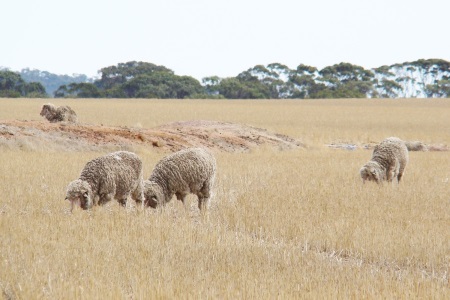Stubbles can be valuable feed for livestock in late summer to early autumn and they are also important in reducing the risk of erosion but a compromise has to be made to feed stock without letting soil wash or blow away.
Feed budgeting is important in determining how much feed is available in a paddock and how long the paddock can be grazed. Assessing the amount of feed in a paddock is just as important as knowing how many tonnes of grain or hay bales are on hand for carrying stock through to the opening rains. When estimating how much feed is on offer in a paddock, first consideration should be given to the susceptibility of the paddock to erosion, for example, is the soil sandy and prone to drift or is it a sloping paddock with a clay soil?
Distribution and structure of stubbles or pasture residues are the most important factors in erosion protection. The best protection for soils prone to wind erosion comes from tall-standing, anchored residues which deflect wind away from the soil surface. On land prone to water erosion, the more the soil surface is covered with residues, the better the protection from raindrop impact.
The amount of residues is not as important. A thick stubble can break down and start to blow around, collecting into dense clumps with bare, drifting soil in between – pulse stubbles are a prime example. Similarly, a paddock of heavy standing stubble with bare soil between the rows of stubble, such as canola, can still suffer water erosion.
Assessing the amount of feed on offer in a paddock requires determination of tonnes or kilograms a hectare of dry matter. While a t/ha figure does not correlate directly with wind or water erosion protection, there are some general guidelines that can be used. The table of minimum cover and desirable cover (see table A) depicts the surface cover needed to protect soil from wind and water erosion.
As an example, a paddock of loamy soil on moderately sloping land requires about 2t/ha of surface cover. If there is about 3t/ha dry matter in total in the paddock, only 1t/ha can be regarded as available feed after an allowance is made for surface cover.

(Source: Gallagher)
Pulse stubbles are particularly difficult to graze without leaving the soil bare. The plants generally do not have a lot of height after harvest, break down quickly because of their high nitrogen content and are easily broken off from the root crown (particularly peas).
Unharvested grain is eagerly sought out by stock, which loosen the soil surface in their quest for the ‘goodies’. Even without grazing, the height and distribution of pulse stubbles after harvest is often inadequate for providing protection on erosion prone soils. Once the surface cover threshold is reached where more grazing would bare the paddock out too much, stock should be moved to another paddock, put into confinement feeding areas or removed from the property completely, either sold or agisted.
These tactics are being used successfully by many producers, resulting in improved soil surface cover levels across the agricultural lands of South Australia.